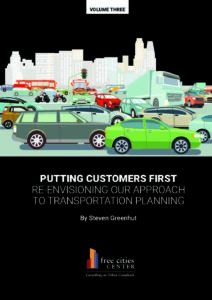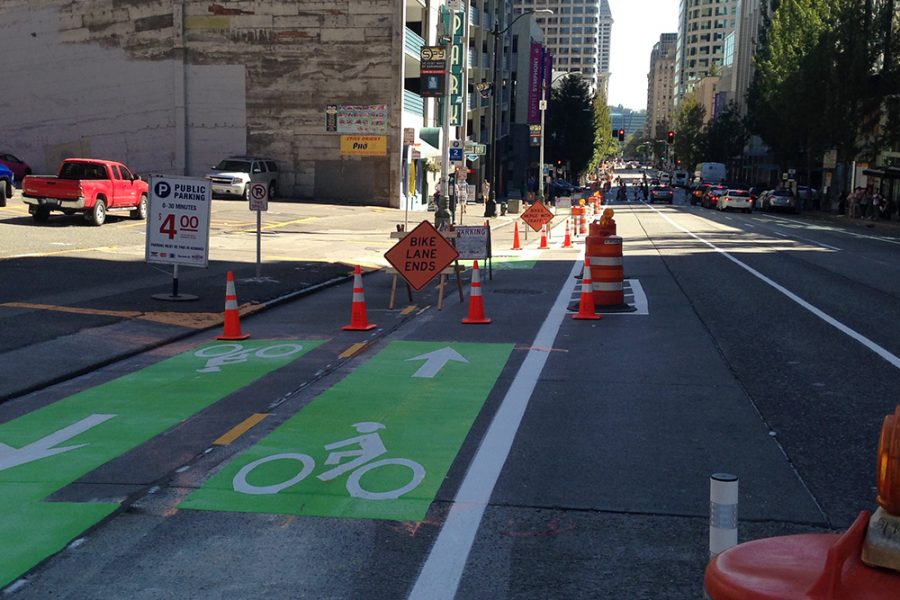One need only spend a little time on a transit-oriented social-media page or reading the thoughts of urban-focused writers to detect a certain disdain toward the automobile, suburbia and the construction of road and freeway lanes. Such attitudes are not outliers, as any quick search of New Urbanist and pro-transit literature will reveal. It’s quickly apparent that many transit advocates are more about transforming the driving public’s behavior than figuring out how to efficiently move people around within our current constraints.
“What driving really means for America is a rather tragic tale that allows most people to entirely escape the comments and connections – weak and strong – that occur in public space of the street,” writes MinnPost columnist Bill Lindeke in a piece headlined, “Why driving is bad for America.” In his view, simple commutes amount to “a Darwinian struggle for asphalt, viewing our neighbors as nothing more than a relentless barrage of competitors for space and speed.” Such hyperbole is not atypical.
 Even in the most environmentally friendly parts of the country, the public strongly supports efforts to reduce traffic congestion via highway expansions. The Oregon Department of Transportation recently conducted a survey that showed 86 percent of Portland-area respondents supportive of efforts to address congestion problems along Interstate 5’s Rose Corridor, yet a group called “No More Freeways” railed against ODOT’s “disastrous, polluting, billion-dollar freeway expansions.”
Even in the most environmentally friendly parts of the country, the public strongly supports efforts to reduce traffic congestion via highway expansions. The Oregon Department of Transportation recently conducted a survey that showed 86 percent of Portland-area respondents supportive of efforts to address congestion problems along Interstate 5’s Rose Corridor, yet a group called “No More Freeways” railed against ODOT’s “disastrous, polluting, billion-dollar freeway expansions.”
One Facebook/webpage group of disgruntled transit advocates is not indicative of public sentiment, but similar – albeit more high-minded – critiques of the automobile are found throughout academia. And academic studies bolster public policies. “Auto-restraint policies often need to be introduced in parallel with Transit Oriented Development (TOD) to off-set the hidden subsidies that promote auto-mobility,” writes Robert Cervero, director of the University of California Transportation Center.
Auto-restraints aren’t a reference to child-car seats or seatbelts, but to a set of policies that include bans on cars in central cities. They also include, “controls on the number of parking spaces, their spatial distribution, parking costs, parking time limits, residential parking permits, taxes, provision of employee parking, and levels of policy enforcement,” according to one Transportation Research Record report. Some of these policies might make sense in specific situations, but their goal is to limit our automobile usage and prod us into transit – not help us get around more efficiently.
California policymakers who presumably rely on automobiles themselves, have for years been taking aim at the evils of our car dependence – even though our largest metropolitan area (Los Angeles) is a product of post-war suburban-style development patterns. In 2006, then-Attorney General Bill Lockyer filed “suit against the Big Six auto companies alleg(ing) that because vehicle exhaust contributes to global warming, the companies should be held financially liable for everything from wildfires to a bad ski season,” the Los Angeles Times reported. That was the first of a long-running campaign by state officials who like to prattle about the “unsustainability” of cars.
A September 2021 article by Gabby Birenbaum in Vox epitomizes the attitude that we, as practical transportation advocates, often face. Titled, “How to end the American obsession with driving,” the article draws on her personal experience: “When I lived in Madrid, I could walk or take transit practically everywhere without ever crossing a highway that had no pedestrian infrastructure. I would take 30-minute walks home in the middle of the night from clubs, when the Metro was not running. Even in the dark, there were no crossings where I was unprotected as a pedestrian.”
For some perspective, Madrid has a population density of 14,000 people per square mile. Most Westerners live in suburban areas. The population density of metropolitan Portland, which imposed an urban-growth boundary to promote densification, is a mere 364 per square mile (5,025 within the city). Obviously, transit makes sense in densely packed areas, but most of us don’t live in those places. A great European college experience isn’t a sound basis for U.S. transportation planning. We’re not really “obsessed” with driving, but driving is the most practical choice for most of us.
Are urban planners and policymakers trying to help people get to their destinations or incentivize us to move into big cities? In my view, a transportation policy that first requires the total re-ordering of urban and suburban design is not so much a transportation policy as a land-use policy. It prioritizes social engineering over civil engineering. Our planning regimen can and perhaps should evolve over time, but in the meantime a proper transportation approach should help Americans get around within the communities they now live while loosening up land-use regulations so that communities can adapt in a natural, bottom-up manner.
Unfortunately, policymakers across the country – but especially in California, Oregon and Washington – are immersed in the anti-driving, pro-density, transit-oriented thinking. This becomes obvious once one starts reading planning documents from the U.S. Department of Transportation, state transportation agencies and regional and local planning agencies. In them, one finds little attention to customer-oriented concerns (safety, scheduling, comfort, convenience) and a lot of attention to greenhouse gases and social equity concerns.
As an example, the California Department of Transportation in 2021 released its California Transportation Plan 2050 – a blueprint for the state’s transportation investments in the coming decades. This is not from a purely transit agency, but the state’s main freeway-building agency (although it does play a key role in transit). This is from its executive summary:
This plan seeks to advance racial and economic justice by redirecting resources to marginalized communities; better connecting individuals to jobs, health care, education and other opportunities; improving environmental justice; and amplifying the voices of those who have been historically excluded from the transportation decision-making process.
The lengthy document offers almost no discussion of the nuts-and-bolts concerns of California drivers – the people who transit advocates presumably need to lure out of their cars. The document gives short shrift to those typical day-to-day concerns from people who simply are trying to get to school, jobs, shopping centers and doctors’ appointments. The plan’s main identified challenges focus on improving public health, adapting to climate change, reducing greenhouse gas emissions, reducing vehicle miles travelled, advancing racial justice, closing the wealth gap, addressing the housing shortage and navigating the impacts of emerging technologies.
If transit planners are serious about luring people onto buses and trains, they need to start viewing those systems primarily as transportation conveyances and not civil-rights and environmental instruments. If they want to help car-dependent Westerners seek out alternatives when appropriate, they need to spend less time haranguing drivers and more time reforming transit systems (and not just by seeking more public funding) so they appeal to potential riders. They need to make these systems better for the small subset of residents who rely on them.
Steven Greenhut is director of the Pacific Research Institute’s Free Cities Center. This column was reprinted from his new PRI book, “Putting Customers First: Re-envisioning Our Approach to Transportation Planning.”


